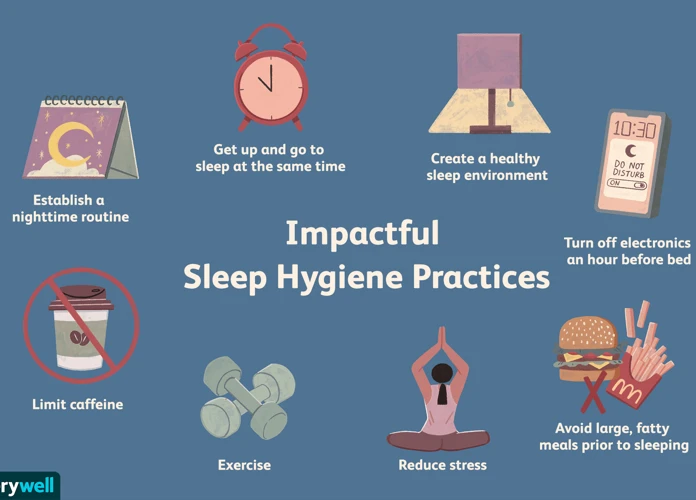Creating a peaceful and restful sleep environment is essential for ensuring a good night’s sleep. We all know how important quality sleep is for our overall well-being, but sometimes it can be challenging to achieve the serene atmosphere needed for a sound slumber. In this article, we will provide you with a step-by-step guide on how to create a relaxing sleep environment. From eliminating noise and optimizing lighting to setting the right temperature and decluttering your bedroom, we will explore various tips and techniques that will help you create a tranquil oasis for a restful night’s sleep. So, let’s dive into the details and discover how you can transform your bedroom into a haven of relaxation and rejuvenation.
1. Eliminate Noise

To create a peaceful sleep environment, it’s crucial to minimize any disturbing noises that can disrupt your sleep. Here are two effective ways to eliminate noise and promote a quiet atmosphere in your bedroom:
White noise machines or apps can be incredibly helpful in drowning out surrounding sounds and creating a soothing ambiance. These devices produce a constant sound that masks other noises, such as traffic, loud neighbors, or even snoring. By using white noise, you can effectively block out distractions and create a more serene environment conducive to sleep. Consider trying a variety of white noise sounds, such as waves crashing or gentle rain, to find what works best for you.
Another effective method of reducing noise is to soundproof your bedroom. Start by identifying sources of noise, such as windows facing a busy street or walls shared with noisy neighbors. Use weatherstripping or caulk to seal any gaps around your windows and door frames, which can help reduce noise infiltration. Additionally, consider hanging heavy curtains, installing soundproofing panels, or using acoustic foam to absorb and dampen sounds within the room. These measures can significantly reduce external noise and create a more tranquil sleep environment.
Creating a noise-free sleep environment is crucial for getting the restful sleep you deserve. By utilizing white noise and soundproofing techniques, you can minimize distractions and enjoy a peaceful night of uninterrupted sleep.
1.1. Use White Noise
One effective way to eliminate noise and create a relaxing sleep environment is to use white noise. White noise refers to a consistent sound that masks other noises and creates a soothing background ambiance. There are various ways to incorporate white noise into your sleep routine:
1. White noise machines: These devices are specifically designed to generate a continuous sound that helps drown out other disturbances. They offer a range of sound options, such as gentle rain, ocean waves, or a humming fan, allowing you to choose the most calming sound for your preferences. Place the white noise machine strategically in your bedroom, close to the source of external noise, for maximum effectiveness.
2. White noise apps: If you prefer a portable solution, there are numerous white noise apps available for smartphones and tablets. These apps provide a wide variety of sound options, including nature sounds, ambient music, or even custom combinations. Simply plug in your headphones or connect your device to a Bluetooth speaker placed near your bed to enjoy the soothing sounds.
Using white noise effectively masks disruptive sounds, allowing your mind to relax and focus on sleep. It’s especially beneficial for individuals who may be sensitive to sudden noises or have trouble falling asleep due to external distractions. Incorporating white noise into your sleep routine can promote a deeper, more restful night’s sleep.
1.2. Soundproof Your Space
To create a peaceful sleep environment, it’s important to take steps to soundproof your space. Here are some effective ways to minimize outside noise and create a quieter atmosphere in your bedroom:
1. Install soundproof curtains: Heavy-duty curtains with multiple layers can help block out noise from outside. Look for curtains specifically designed for soundproofing, as they often have thick, dense materials that absorb sound waves. Hang these curtains over your windows to reduce the amount of noise entering your room.
2. Use weatherstripping: Seal any gaps or cracks around your windows and doors with weatherstripping. This can prevent noise from infiltrating your bedroom and disturbing your sleep. Choose high-quality weatherstripping materials that are durable and effective in blocking sound waves.
3. Add rugs and carpets: Hard surfaces, such as wood or tile floors, can reflect and amplify sound. By placing rugs or carpets in your bedroom, you can help absorb and dampen noise. Opt for thicker, plush carpets or rugs with padding underneath for better sound insulation.
4. Use acoustic panels: Consider installing acoustic panels on the walls of your bedroom. These panels are designed to absorb sound and reduce echoes within a space. They can be particularly helpful if you live in an apartment building or have noisy neighbors.
5. Close gaps in doors: Check if your bedroom door has any gaps between the door and the floor or frame. These gaps can be a pathway for noise to enter your room. Seal them with door sweeps or draft stoppers to minimize sound transmission.
By implementing these soundproofing techniques, you can create a quieter sleep environment that promotes a restful night’s sleep. Remember, reducing external noise can greatly contribute to your overall sleep quality and help you wake up feeling refreshed and rejuvenated.
2. Optimize Lighting

When it comes to creating a relaxing sleep environment, optimizing lighting is crucial. Here are two ways you can effectively manage lighting in your bedroom to promote better sleep:
1. Use blackout curtains or blinds: These light-blocking window treatments are specifically designed to keep out external light sources, such as streetlights or early morning sunlight. By eliminating unwanted light, you can create a dark and serene atmosphere that signals your body it’s time to sleep. Install blackout curtains or blinds in your bedroom and ensure they are properly fitted to minimize any light leakage.
2. Dim the lights before bed: Bright lights in the evening can disrupt your body’s natural sleep-wake cycle by signaling it’s still daytime. To create a more relaxed environment, dim the lights in your bedroom in the hour or so leading up to bedtime. Use lamps with adjustable settings or install dimmer switches to control the level of light. Consider using warm, soft lighting to create a soothing and cozy atmosphere, which can help induce feelings of relaxation.
By optimizing the lighting in your bedroom, you can create an environment that promotes restful sleep. Implementing blackout curtains or blinds and dimming the lights before bed can help signal to your body that it’s time to unwind and prepare for sleep. Remember, the goal is to create a peaceful and dark sleep environment that supports your natural sleep patterns.
2.1. Use Blackout Curtains
When it comes to optimizing lighting in your sleep environment, using blackout curtains can make a significant difference in promoting a restful night’s sleep. These specialty curtains are designed to block out external light sources, such as streetlights or the early morning sun, creating a dark and serene atmosphere in your bedroom.
Blackout curtains are made of thick, opaque fabric that effectively prevents light from entering the room. They are typically layered or lined with multiple layers of fabric to enhance light-blocking abilities. By installing blackout curtains, you can regulate the amount of natural and artificial light that enters your bedroom, which can help regulate your body’s sleep-wake cycle.
Light plays a crucial role in regulating our circadian rhythm, the natural sleep-wake cycle that governs our body’s internal clock. When exposed to bright light in the evening or early morning, our brain receives signals that indicate it’s time to be awake and alert. By using blackout curtains, you can create a dark environment that signals your brain that it’s time to sleep.
Blackout curtains not only promote better sleep but also offer additional benefits. They can help reduce noise transmission, provide privacy, and help regulate room temperature by insulating against heat or cold. These curtains come in various styles, colors, and sizes, allowing you to choose the ones that best suit your bedroom decor.
Incorporating blackout curtains into your sleep environment can enhance your sleep quality and create a cozy, peaceful space for relaxation. Combined with other strategies such as dimming the lights, you can create an optimal sleep environment that supports healthy sleep patterns. So, consider installing blackout curtains to enjoy the benefits of a dark, tranquil bedroom conducive to restorative sleep.
2.2. Dim the Lights
To optimize lighting in your sleep environment, it’s important to dim the lights in your bedroom. Here are a few methods to achieve a softer and more relaxing lighting atmosphere:
1. Use dimmer switches: Install dimmer switches on your bedroom lights to have control over the brightness levels. This allows you to adjust the light according to your preferences and create a calming environment before bedtime. Dimmed lights help signal to your brain that it’s time to wind down and prepare for sleep.
2. Lampshades and lamp dimmers: Replace bright light bulbs with lower wattage options, and consider adding lampshades to diffuse the light further. Lamp dimmers are also a great addition as they allow you to easily adjust the brightness to suit your needs. Soft, warm-toned lighting can enhance relaxation and promote a cozy atmosphere in your bedroom.
3. Use candles or salt lamps: Consider using candles or Himalayan salt lamps as alternative sources of dim lighting. These natural light sources emit a soft, warm glow that can create a tranquil ambiance in your sleep environment. Just be sure to practice safety precautions when using candles, such as placing them in sturdy holders and never leaving them unattended.
By dimming the lights in your bedroom, you reduce the exposure to bright, stimulating light that can disrupt your sleep patterns. Creating a soothing and subdued lighting environment is an integral part of promoting relaxation and preparing your body for a restful night’s sleep.
3. Set the Right Temperature

When it comes to creating a relaxing sleep environment, setting the right temperature is crucial for optimal comfort. Consider the following steps to ensure your bedroom temperature promotes a restful night’s sleep:
3.1. Adjust Your Thermostat: Optimize your room temperature by setting your thermostat to a cool and comfortable level. The National Sleep Foundation suggests keeping your bedroom between 60-67°F (15-19°C) for optimal sleep. Experiment with different temperatures to find what works best for you, as individual preferences may vary.
3.2. Use Appropriate Bedding: Selecting the right bedding materials can further help regulate your body temperature throughout the night. Choose breathable fabrics like cotton or bamboo, as they allow for better airflow and moisture wicking, keeping you cool during warm nights. Conversely, during colder seasons, consider layering blankets or using a down comforter to provide warmth and coziness.
Maintaining an ideal room temperature is essential for achieving deeper and more restorative sleep. By adjusting your thermostat and selecting appropriate bedding, you can create a sleep environment that encourages comfort and relaxation. Remember, a temperature that suits your needs may vary, so prioritize finding the optimal balance for a restful night’s sleep.
3.1. Adjust Your Thermostat
Adjusting the thermostat in your bedroom can significantly impact the quality of your sleep. The recommended temperature for a restful sleep typically falls between 60 to 67 degrees Fahrenheit (15-19 degrees Celsius). However, individual preferences may vary, so it’s important to find a temperature that is comfortable for you.
Maintaining a cool temperature in your bedroom helps regulate your body’s internal temperature, which naturally drops during sleep. When your body temperature is cooler, it promotes better sleep and reduces the chances of waking up due to discomfort or night sweats. Consider using a programmable thermostat that allows you to set the temperature lower during the night and warmer in the morning to align with your sleep schedule.
If you struggle with insomnia or find it challenging to fall asleep, adjusting the thermostat and creating a cool environment can be especially beneficial. Cooler temperatures have been shown to improve sleep quality and help manage conditions like stress-induced insomnia. So, if you’re having trouble with sleep, it may be worth exploring the impact of temperature regulation and how it can influence your sleep patterns. For more information on managing insomnia related to stress, you can check out our article on stress-induced insomnia.
Remember, finding the right temperature for your sleep environment is a personal journey. Experiment with adjusting your thermostat to create a comfortable and conducive atmosphere for a restful night’s sleep.
3.2. Use Appropriate Bedding
Choosing appropriate bedding is essential for creating a comfortable and relaxing sleep environment. Here are a few tips to help you select the right bedding for a restful night’s sleep:
1. Mattress: Your mattress plays a vital role in determining your sleep quality and comfort. Consider investing in a high-quality mattress that provides adequate support for your body. There are various types of mattresses available, such as memory foam, latex, and hybrid mattresses. Each type has its own benefits, so it’s important to choose one that suits your preferences and sleep needs. Remember to replace your mattress every 7-10 years to ensure optimal support and comfort.
2. Sheets: Opt for soft and breathable sheets made from natural materials, such as cotton or bamboo. These fabrics are breathable, hypoallergenic, and help regulate your body temperature during sleep. Look for sheets with a higher thread count for a luxurious and cozy feel.
3. Pillows: Finding the perfect pillow is crucial for proper neck and spine alignment. There are various types of pillows available, including memory foam, down, and latex pillows. Choose a pillow that supports your preferred sleep position and provides the necessary neck and head support.
4. Blankets and Comforters: Select blankets and comforters that are appropriate for the current season and your personal preference for warmth. Consider using multiple layers of bedding, such as a lightweight blanket combined with a duvet or comforter, so you can easily adjust the layers to achieve your desired level of coziness.
By using appropriate bedding, you can enhance your sleep environment and improve your overall sleep quality. Remember to regularly clean and maintain your bedding to ensure freshness and prolong its lifespan. Visit our article on diet and managing insomnia for additional tips on how nutrition can affect your sleep patterns and quality.
4. Invest in a Comfortable Mattress and Pillow

Investing in a comfortable mattress and pillow is essential for achieving a restful sleep. Here are two key factors to consider when selecting the right mattress and pillow for optimal comfort:
1. Choose the Right Mattress:
– Consider your preferred sleeping position: Different sleeping positions require different levels of firmness and support. For example, side sleepers often benefit from a softer mattress that provides adequate cushioning for the shoulders and hips. Back and stomach sleepers, on the other hand, may need a firmer mattress to maintain proper spinal alignment.
– Test out different mattress types: There are various mattress types available, including memory foam, latex, innerspring, and hybrid mattresses. Each type offers unique benefits in terms of comfort, support, and pressure relief. Take the time to try out different options and determine which one feels most comfortable and supportive for your body.
2. Find the Perfect Pillow:
– Consider your sleeping position: Just like with mattresses, your sleeping position will influence the type of pillow that suits you best. Side sleepers may benefit from a higher loft pillow to keep the neck aligned with the spine. Back and stomach sleepers often find flatter pillows more comfortable.
– Choose the right filling: Pillows come in a variety of materials, including down, memory foam, latex, and polyester. Each filling type offers a different level of support and responsiveness. Consider your personal preferences and any specific neck or back issues you may have when selecting the filling material.
By investing in a comfortable mattress and pillow that suit your specific needs and preferences, you can maximize your sleep comfort and support. Remember, quality sleep is vital for overall health and well-being, so don’t overlook the importance of a cozy and supportive sleep surface.
4.1. Choose the Right Mattress
When it comes to creating a relaxing sleep environment, choosing the right mattress is of utmost importance. An uncomfortable mattress can lead to sleep disturbances and discomfort throughout the night. Here are a few factors to consider when selecting a mattress:
1. Firmness: The level of firmness is subjective and varies from person to person. Consider your individual preferences and any specific needs you may have, such as back pain or joint issues. Firm mattresses provide more support, while softer ones offer more cushioning. Find a balance that suits your comfort level.
2. Material: Different materials offer varying levels of support and comfort. Memory foam mattresses conform to your body shape and provide pressure relief, while innerspring mattresses offer more bounce and support. Latex mattresses are known for their durability and responsiveness. Explore different mattress materials to find the one that suits your needs.
3. Motion Transfer: If you sleep with a partner, consider a mattress with minimal motion transfer. This feature ensures that movement on one side of the bed doesn’t disturb the other person. Memory foam mattresses are known for their excellent motion isolation properties.
4. Cooling Properties: If you tend to sleep hot, look for a mattress that promotes airflow and heat dissipation. Gel-infused memory foam or mattresses with breathable covers can help regulate temperature and keep you cool throughout the night.
When shopping for a mattress, take advantage of in-store trials or online return policies to ensure you’re fully satisfied with your purchase. A comfortable and supportive mattress can make a significant difference in the quality of your sleep and contribute to a more relaxing sleep environment.
If you’re interested in exploring alternative therapies to promote sleep, you can find more information in our article on alternative therapies for managing insomnia.
4.2. Find the Perfect Pillow
Finding the perfect pillow is essential for creating a comfortable sleep environment and ensuring a restful night’s sleep. Here are some factors to consider when searching for the ideal pillow:
1. Support: Look for a pillow that provides adequate support for your head, neck, and spine alignment. The right pillow should keep your neck in a neutral position, reducing any strain or discomfort.
2. Material: Pillows come in various materials, including memory foam, latex, down feathers, and synthetic fills. Each material has its own unique feel and level of support. Take into account your personal preferences, allergies, and any specific needs, such as neck pain or allergies, when selecting a pillow material.
3. Loft: The loft, or height, of the pillow is another important factor to consider. Side sleepers usually benefit from a higher loft pillow to maintain proper alignment, while stomach sleepers may prefer a lower loft to minimize strain on the neck.
4. Sleep position: Your sleep position also plays a role in determining the type of pillow that will work best for you. Back sleepers typically require a medium loft pillow, while stomach sleepers need a softer and flatter pillow. Side sleepers might prefer a firmer pillow with more support.
5. Trial and error: Finding the perfect pillow may involve some trial and error. Consider purchasing pillows with a return policy, so you can test them out for a few nights to determine if they provide the comfort and support you need.
Remember, everyone’s preferences and needs are different, so what works for one person may not work for another. Take your time to explore different options and find the perfect pillow that suits your specific requirements. Your pillow choice can make a significant difference in the quality of your sleep and overall comfort.
5. Declutter Your Bedroom

Decluttering your bedroom is an essential step in creating a relaxing sleep environment. By removing unnecessary items and organizing your space, you can cultivate a sense of calm and serenity. Here are two strategies to help you declutter your bedroom effectively:
1. Tidy Up Regularly: Establish a habit of tidying up your bedroom on a regular basis. Start by setting aside some time each day or week to declutter and organize. Begin by sorting through items and deciding what to keep, donate, or discard. Remove any items that don’t belong in the bedroom, like work-related materials or exercise equipment. Make sure everything has its designated place and find storage solutions for items that tend to create clutter, such as clothes, books, or accessories. By keeping surfaces clear and well-organized, you can create a more peaceful and relaxing atmosphere.
2. Create Storage Solutions: Investing in storage solutions is vital for keeping your bedroom organized and clutter-free. Consider using storage bins, baskets, or shelves to store items like extra blankets, pillows, or personal belongings. Utilize under-bed storage containers to maximize space and keep items out of sight. By finding practical and aesthetically pleasing storage solutions, you can maintain a clean and tranquil sleep environment.
Decluttering your bedroom not only enhances its visual appeal but also promotes a sense of calmness and tranquility. By regularly tidying up and implementing storage solutions, you can create a serene space that fosters relaxation and improves the quality of your sleep.
5.1. Tidy Up Regularly
Maintaining a tidy and clutter-free bedroom is essential for creating a relaxing sleep environment. Regular tidying up not only improves the overall aesthetics of your room but can also positively impact your mental well-being. Here are some tips for tidying up regularly:
1. Make your bed daily: Start your day by making your bed. It sets the tone for tidiness and instantly makes your room appear neat and organized.
2. Clear surfaces: Remove any unnecessary items from your nightstand, dressers, and other surfaces in your bedroom. Clearing surfaces of clutter creates a sense of calm and promotes relaxation.
3. Organize your belongings: Sort through your belongings and find appropriate storage solutions. Use bins, baskets, or drawer dividers to keep items organized and easily accessible. This helps minimize visual clutter and creates a more peaceful atmosphere.
4. Put clothes away: Avoid leaving clothes strewn across your bedroom floor or draped over furniture. Invest in a laundry hamper or designated storage for dirty clothes, and be diligent about hanging up clean clothes or folding them away.
5. Minimize decor: While it’s nice to have a few decorative items in your bedroom, too many can create a cluttered and overwhelming atmosphere. Opt for minimalistic decor and keep only the items that bring you joy or a sense of tranquility.
Regularly tidying up your bedroom not only improves the physical environment but also helps to declutter your mind. A clean and organized space allows you to relax more easily, promoting a restful sleep experience. So take the time to tidy up your bedroom regularly and enjoy the benefits of a serene sleep environment.
5.2. Create Storage Solutions
When it comes to creating a relaxing sleep environment, having a clutter-free bedroom is essential. Clutter not only affects our physical space but also our mental state, leading to increased stress and difficulty in falling asleep. One effective way to declutter your bedroom is by creating smart storage solutions. Here are a few ideas to help you get started:
Incorporate under-bed storage: Utilize the space under your bed by investing in storage containers or bins that can slide easily underneath. This is a great way to store items such as extra blankets, pillows, or seasonal clothing, keeping them out of sight and maintaining a clean and organized bedroom.
Maximize closet space: A well-organized closet can do wonders for creating a peaceful atmosphere. Consider installing shelves, hanging organizers, or shoe racks to maximize the available space. This will help you keep your belongings neatly arranged, making it easier to find what you need while keeping your bedroom clutter-free.
Utilize wall space: Make use of vertical space by installing shelves or hanging organizers on the walls. This can be a great option for displaying decorative items or storing books and accessories. By utilizing wall space, you can keep your surfaces clear and create a more spacious and calming bedroom environment.
Invest in multi-purpose furniture: Look for furniture pieces that serve dual purposes, such as ottomans or benches with hidden storage compartments. These can be excellent options for storing extra blankets or pillows while also providing additional seating or a place to rest your feet.
By implementing these storage solutions, you can effectively declutter your bedroom and create a more serene sleep environment. A clean and organized space will promote a sense of calmness, making it easier to relax and unwind at the end of the day. So, get creative with your storage options and enjoy a clutter-free sanctuary for a restful night’s sleep.
6. Create a Tranquil Atmosphere
To ensure a restful sleep, it’s essential to create a tranquil atmosphere in your bedroom. By incorporating calming elements, you can create a serene and peaceful space that promotes relaxation and sleep. Here are two ways to create a tranquil atmosphere in your bedroom:
1. Use Calming Colors: Choose a color palette that evokes a sense of tranquility and calmness. Opt for soft, muted shades such as blues, greens, or pastels. These colors have a soothing effect on the mind and can help create a tranquil ambiance. Consider painting your walls in these calming hues or incorporating them through bedding, pillows, or decorative accents.
2. Incorporate Relaxing Scents: Aromatherapy can play a significant role in creating a relaxing environment for sleep. Use essential oils like lavender, chamomile, or jasmine, known for their calming properties. You can diffuse these oils in a bedroom diffuser or use linen sprays or scented candles with these soothing scents. The gentle aroma will help relax your mind and body, preparing you for a peaceful night’s sleep.
By using calming colors and incorporating relaxing scents, you can transform your bedroom into a tranquil haven that promotes deep, restful sleep. These simple yet effective techniques can contribute to a serene atmosphere, allowing you to unwind and drift off to sleep with ease.
6.1. Use Calming Colors
When it comes to creating a tranquil sleep environment, the colors you choose for your bedroom can have a significant impact on your mood and relaxation levels. Here are some tips for using calming colors to enhance the soothing atmosphere in your bedroom:
1. Soft Blues: Shades of blue, such as sky blue or pale aqua, are known for their calming and serene qualities. These colors can evoke a sense of tranquility and help to lower blood pressure and heart rate, promoting a more restful sleep.
2. Gentle Greens: Green is often associated with nature and can create a sense of calmness and harmony in your bedroom. Opt for soft, muted shades of green to evoke a peaceful and refreshing ambiance.
3. Soothing Neutrals: Neutral shades like beige, taupe, or soft gray can create a serene and balanced environment. These colors have a calming effect and can help reduce stress and anxiety levels, allowing you to unwind and prepare for a good night’s sleep.
4. Warm Earth Tones: Colors inspired by nature, such as warm browns or soft earthy tones, can induce a sense of comfort and relaxation. These hues provide a cozy and grounding atmosphere that promotes a restorative sleep experience.
Remember, the key is to choose colors that are soothing to you personally. Experiment with different color combinations and textures to create a sleep environment that reflects your unique taste and promotes relaxation. By incorporating calming colors into your bedroom design, you can set the stage for a tranquil and rejuvenating sleep experience.
6.2. Incorporate Relaxing Scents
Incorporating relaxing scents into your sleep environment can have a powerful impact on your ability to unwind and drift off to sleep. Here are a few ways you can integrate soothing aromas into your bedroom:
1. Essential Oils: Essential oils have long been used for their therapeutic properties and can help create a tranquil atmosphere in your bedroom. Lavender, chamomile, and ylang-ylang are known for their calming effects and promoting relaxation. Add a few drops of these oils to a diffuser or mix them with a carrier oil and apply to your pulse points or pillow for a gentle and soothing scent.
2. Linen Spray: Another way to incorporate relaxing scents is by using linen sprays. These sprays are typically made with a combination of essential oils and water. Spritzing your pillows and bedding with a calming scent like lavender or vanilla can create a peaceful ambiance and help you unwind before bed.
3. Scented Candles: Lighting scented candles in your bedroom can set a calming mood and fill the air with delightful fragrances. Opt for candles with natural ingredients and subtle scents to avoid overwhelming the space. Always remember to blow out candles before falling asleep to ensure safety.
4. Herbal Sachets: Herbal sachets filled with dried lavender, chamomile, or other relaxing herbs can be placed under your pillow or near your bed to create a gentle and soothing aroma. These sachets can also be used in your drawers or wardrobe, making your entire bedroom smell wonderful.
When incorporating relaxing scents into your sleep environment, it’s essential to choose aromas that you find personally soothing and pleasant. Experiment with different scents to find what works best for you, and remember to use them in moderation, as overpowering smells may have the opposite effect. By incorporating these relaxing scents into your sleep routine, you can create an atmosphere that promotes calmness and aids in a restful night’s sleep.
Conclusion
In conclusion, creating a relaxing sleep environment is essential for promoting healthy sleep patterns and ensuring a restful night’s sleep. By following the tips and techniques discussed in this article, you can transform your bedroom into a peaceful oasis that promotes relaxation and rejuvenation. Eliminating noise with the help of white noise machines or soundproofing methods can significantly reduce distractions and create a quieter atmosphere. Optimizing lighting through the use of blackout curtains and dimming lights can create a more soothing ambiance that promotes sleep. Setting the right temperature and investing in a comfortable mattress and pillow can enhance comfort and support for a night of deep sleep. Decluttering your bedroom and creating a tranquil atmosphere with calming colors and relaxing scents can further contribute to a calm and peaceful sleep environment. By implementing these steps, you can create the perfect sleep sanctuary that will help you unwind, relax, and enjoy a night of restorative sleep. Sweet dreams!
Frequently Asked Questions
1. How does noise affect sleep quality?
Noise can greatly impact sleep quality by causing disruptions and preventing you from falling asleep or staying asleep. It can lead to lighter, fragmented sleep, resulting in feelings of tiredness and grogginess the next day.
2. What is white noise, and how does it help with sleep?
White noise is a type of gentle, consistent background sound that can mask other noises. It helps to create a soothing environment by reducing the contrast between surrounding sounds and promoting relaxation and better sleep.
3. Can I use headphones or earphones to drown out noise while sleeping?
Using headphones or earphones while sleeping is not recommended. It can be uncomfortable and may pose a safety risk. Instead, opt for white noise machines or apps specifically designed for sleep.
4. Are there any natural alternatives to white noise for creating a peaceful sleep environment?
Yes, there are natural alternatives such as nature sounds, calming music, or even a quiet fan. Experiment with different sounds to find what works best for you and promotes relaxation.
5. How can I identify and soundproof sources of noise in my bedroom?
To identify sources of noise, listen for sounds from outside your bedroom or from neighboring areas. Areas with gaps or cracks are often entry points for noise. To soundproof, use weatherstripping, seal gaps, hang heavy curtains, or use acoustic foam to absorb and dampen sounds.
6. Can noise-canceling headphones be used for a peaceful sleep environment?
Noise-canceling headphones can be effective in quieting external noises, but they might not be comfortable to wear while sleeping. Additionally, they carry a risk of discomfort or potential injury during movements while sleeping.
7. Does the volume of white noise need to be loud to be effective in promoting sleep?
No, the sound of white noise does not need to be overly loud. The volume should be set at a comfortable level, enough to mask other noises without being overpowering.
8. Can using white noise lead to dependency and difficulty sleeping without it?
No, using white noise to promote sleep is generally safe and does not lead to dependency. It can, however, create a consistent and soothing sleep environment, making it more challenging to fall asleep without it initially.
9. Can I combine white noise with other sleep-enhancing methods?
Absolutely! Combining white noise with other sleep-enhancing methods like aromatherapy, comfortable bedding, or a bedtime routine can further promote relaxation and improve sleep quality.
10. How long should I use white noise during sleep?
The duration of using white noise during sleep varies from person to person. It can be used throughout the night or set on a timer to turn off after a certain period. Experiment to find what works best for your sleep needs and preferences.








